Literature Review on Cost Overruns in Public Construction Projects
VerifiedAdded on 2022/11/18
|13
|3947
|216
Literature Review
AI Summary
This literature review examines the pervasive issue of cost overruns in public construction projects. It begins by defining cost overruns and highlighting their prevalence, particularly in developing nations, where actual costs can significantly exceed budgets. The review explores various causes, including inadequate planning, inaccurate material estimates, equipment costs, and delays. It differentiates between the causes in developed and developing countries, noting the impact of corruption and resource management. The document further details specific causes of overruns, such as unplanned costs due to financial changes, communication breakdowns, scope creep, project complexity underestimation, unrealistic cost estimates, inadequate financing, project delays, contractor inexperience, lack of coordination, absence of contingency plans, high machine costs, and time constraints. The review emphasizes the need for effective operational strategies to manage resources efficiently and mitigate excessive spending, especially considering the fragmentation inherent in public projects. It also highlights the importance of anticipating future costs, managing supply chains, and developing robust contingency plans to avoid significant cost overruns.
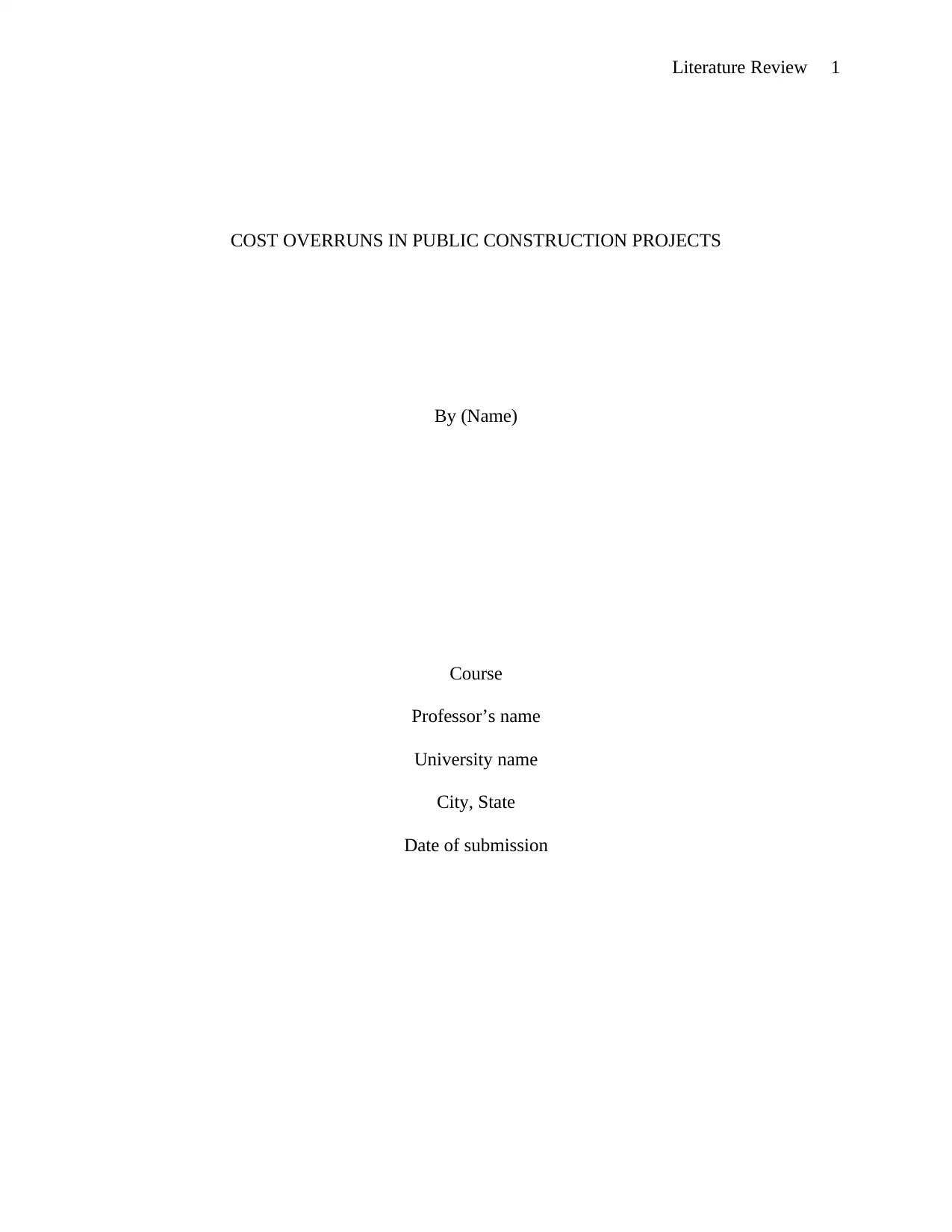
Literature Review 1
COST OVERRUNS IN PUBLIC CONSTRUCTION PROJECTS
By (Name)
Course
Professor’s name
University name
City, State
Date of submission
COST OVERRUNS IN PUBLIC CONSTRUCTION PROJECTS
By (Name)
Course
Professor’s name
University name
City, State
Date of submission
Paraphrase This Document
Need a fresh take? Get an instant paraphrase of this document with our AI Paraphraser

Literature Review 2
Literature Review
According to Ameh, et al., (2010: 53), cost overruns refer to incurred expenditures above those
that are included in the budget which arise due to an initial underestimation of the project cost or
inflation of costs before the project gets underway. Amoa & Allotey, (2014: 58) describe it as a
failure to achieve the contract goals within the assigned contract budget. They are the most
widespread problem in construction sites all over the world, and this is especially true in
developing nations including Oman, where the actual cost of construction could turn out to be up
to 100% more than the budgeted amount (Kamaruzzaman & Ali 2010: 112). A comprehensive
worldwide research that was carried out by Lidelöw & Simu (2015: 54) found out that 9 out of
10 Public construction projects experience project overrun which defiantly shows that it is a
common problem in the construction industry. The opposite of this is cost under runs, and this
rarely happen. This has been attributed to the fact that as countries develop they undertake many
development projects, and they attempt to do them with the technologies used by developed
countries which they do not have experience with (Amu & Adesanya 2011: 62). Technology
applied in construction will vary with differences like terrain and location. The novelty of some
constructions in these areas means that there will be a lot of estimation and some of it is bound to
lack accuracy (Amu & Adesanya, 2011: 64). Problems that could arise from these to cause cost
overruns include inadequate preparation and planning for the project, wrongful estimates for
materials, overinflated costs of equipment acquisition, weather, condition of the site, increased
quantities of materials, incompetent workers, delayed start of the construction, and delayed
supply of raw materials and equipment (Azlan & Syuhada 2014: 250).
Ismail, et al., (2014: 12) propose budgeting as one of the most important aspects that is
considered before commencing a construction project and could potentially determine whether
Literature Review
According to Ameh, et al., (2010: 53), cost overruns refer to incurred expenditures above those
that are included in the budget which arise due to an initial underestimation of the project cost or
inflation of costs before the project gets underway. Amoa & Allotey, (2014: 58) describe it as a
failure to achieve the contract goals within the assigned contract budget. They are the most
widespread problem in construction sites all over the world, and this is especially true in
developing nations including Oman, where the actual cost of construction could turn out to be up
to 100% more than the budgeted amount (Kamaruzzaman & Ali 2010: 112). A comprehensive
worldwide research that was carried out by Lidelöw & Simu (2015: 54) found out that 9 out of
10 Public construction projects experience project overrun which defiantly shows that it is a
common problem in the construction industry. The opposite of this is cost under runs, and this
rarely happen. This has been attributed to the fact that as countries develop they undertake many
development projects, and they attempt to do them with the technologies used by developed
countries which they do not have experience with (Amu & Adesanya 2011: 62). Technology
applied in construction will vary with differences like terrain and location. The novelty of some
constructions in these areas means that there will be a lot of estimation and some of it is bound to
lack accuracy (Amu & Adesanya, 2011: 64). Problems that could arise from these to cause cost
overruns include inadequate preparation and planning for the project, wrongful estimates for
materials, overinflated costs of equipment acquisition, weather, condition of the site, increased
quantities of materials, incompetent workers, delayed start of the construction, and delayed
supply of raw materials and equipment (Azlan & Syuhada 2014: 250).
Ismail, et al., (2014: 12) propose budgeting as one of the most important aspects that is
considered before commencing a construction project and could potentially determine whether
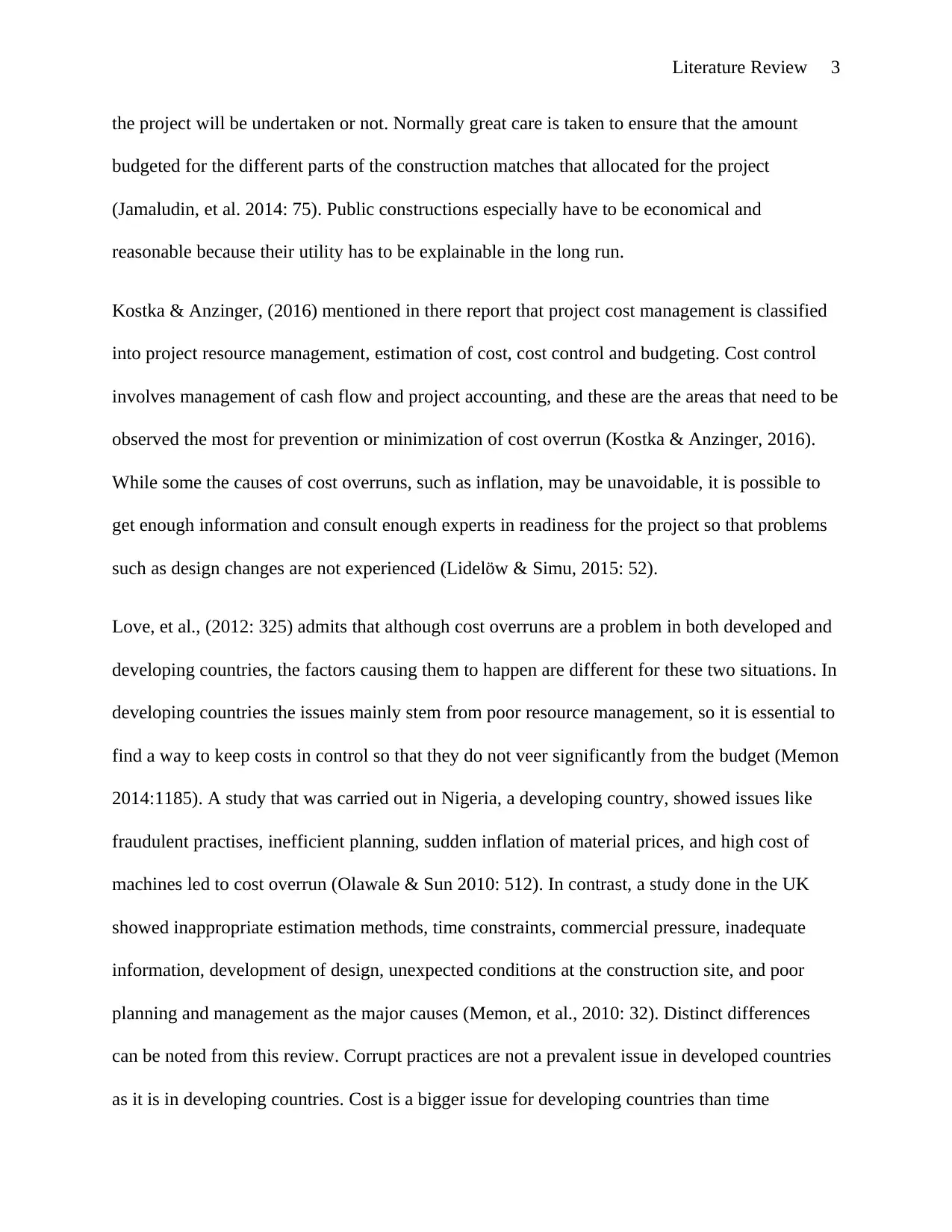
Literature Review 3
the project will be undertaken or not. Normally great care is taken to ensure that the amount
budgeted for the different parts of the construction matches that allocated for the project
(Jamaludin, et al. 2014: 75). Public constructions especially have to be economical and
reasonable because their utility has to be explainable in the long run.
Kostka & Anzinger, (2016) mentioned in there report that project cost management is classified
into project resource management, estimation of cost, cost control and budgeting. Cost control
involves management of cash flow and project accounting, and these are the areas that need to be
observed the most for prevention or minimization of cost overrun (Kostka & Anzinger, 2016).
While some the causes of cost overruns, such as inflation, may be unavoidable, it is possible to
get enough information and consult enough experts in readiness for the project so that problems
such as design changes are not experienced (Lidelöw & Simu, 2015: 52).
Love, et al., (2012: 325) admits that although cost overruns are a problem in both developed and
developing countries, the factors causing them to happen are different for these two situations. In
developing countries the issues mainly stem from poor resource management, so it is essential to
find a way to keep costs in control so that they do not veer significantly from the budget (Memon
2014:1185). A study that was carried out in Nigeria, a developing country, showed issues like
fraudulent practises, inefficient planning, sudden inflation of material prices, and high cost of
machines led to cost overrun (Olawale & Sun 2010: 512). In contrast, a study done in the UK
showed inappropriate estimation methods, time constraints, commercial pressure, inadequate
information, development of design, unexpected conditions at the construction site, and poor
planning and management as the major causes (Memon, et al., 2010: 32). Distinct differences
can be noted from this review. Corrupt practices are not a prevalent issue in developed countries
as it is in developing countries. Cost is a bigger issue for developing countries than time
the project will be undertaken or not. Normally great care is taken to ensure that the amount
budgeted for the different parts of the construction matches that allocated for the project
(Jamaludin, et al. 2014: 75). Public constructions especially have to be economical and
reasonable because their utility has to be explainable in the long run.
Kostka & Anzinger, (2016) mentioned in there report that project cost management is classified
into project resource management, estimation of cost, cost control and budgeting. Cost control
involves management of cash flow and project accounting, and these are the areas that need to be
observed the most for prevention or minimization of cost overrun (Kostka & Anzinger, 2016).
While some the causes of cost overruns, such as inflation, may be unavoidable, it is possible to
get enough information and consult enough experts in readiness for the project so that problems
such as design changes are not experienced (Lidelöw & Simu, 2015: 52).
Love, et al., (2012: 325) admits that although cost overruns are a problem in both developed and
developing countries, the factors causing them to happen are different for these two situations. In
developing countries the issues mainly stem from poor resource management, so it is essential to
find a way to keep costs in control so that they do not veer significantly from the budget (Memon
2014:1185). A study that was carried out in Nigeria, a developing country, showed issues like
fraudulent practises, inefficient planning, sudden inflation of material prices, and high cost of
machines led to cost overrun (Olawale & Sun 2010: 512). In contrast, a study done in the UK
showed inappropriate estimation methods, time constraints, commercial pressure, inadequate
information, development of design, unexpected conditions at the construction site, and poor
planning and management as the major causes (Memon, et al., 2010: 32). Distinct differences
can be noted from this review. Corrupt practices are not a prevalent issue in developed countries
as it is in developing countries. Cost is a bigger issue for developing countries than time
⊘ This is a preview!⊘
Do you want full access?
Subscribe today to unlock all pages.

Trusted by 1+ million students worldwide
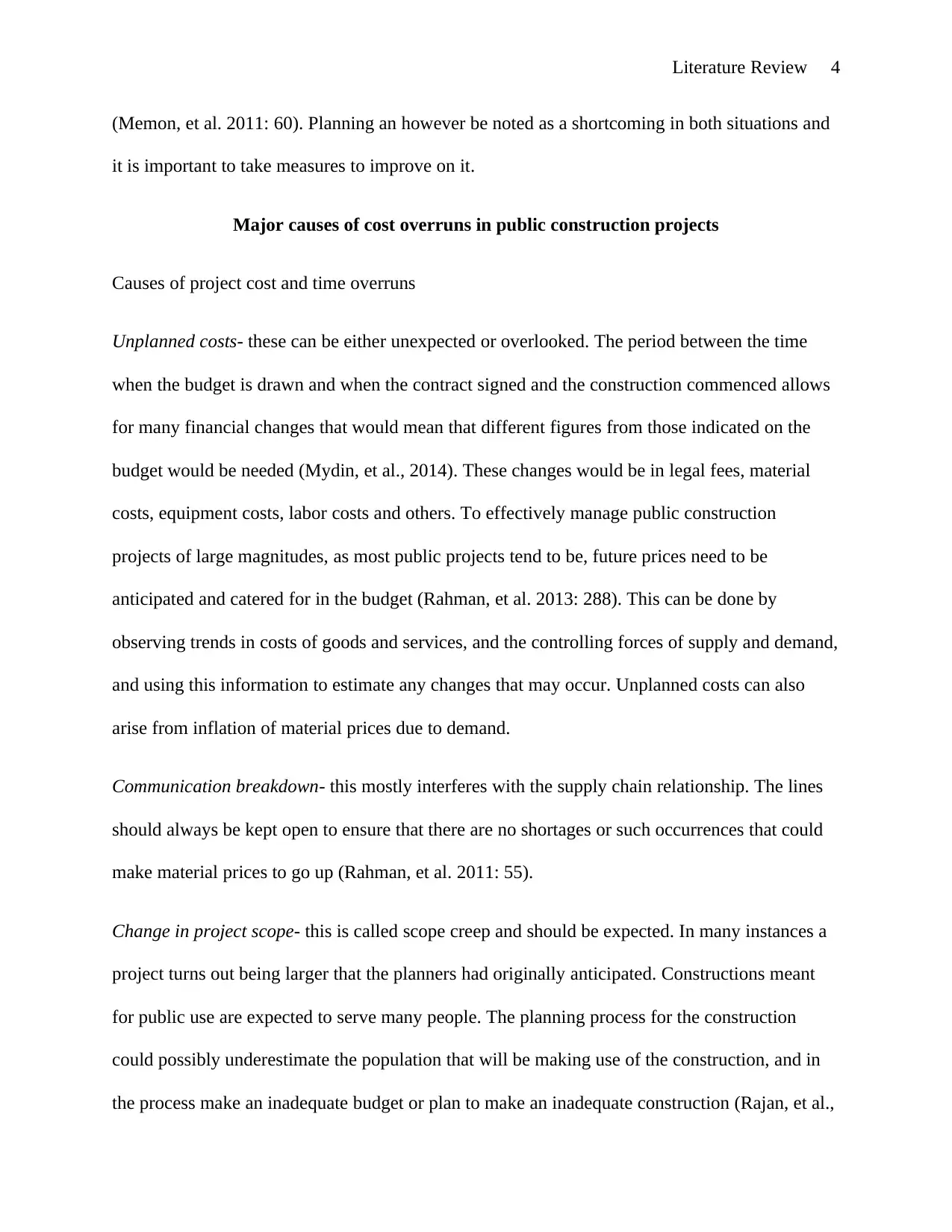
Literature Review 4
(Memon, et al. 2011: 60). Planning an however be noted as a shortcoming in both situations and
it is important to take measures to improve on it.
Major causes of cost overruns in public construction projects
Causes of project cost and time overruns
Unplanned costs- these can be either unexpected or overlooked. The period between the time
when the budget is drawn and when the contract signed and the construction commenced allows
for many financial changes that would mean that different figures from those indicated on the
budget would be needed (Mydin, et al., 2014). These changes would be in legal fees, material
costs, equipment costs, labor costs and others. To effectively manage public construction
projects of large magnitudes, as most public projects tend to be, future prices need to be
anticipated and catered for in the budget (Rahman, et al. 2013: 288). This can be done by
observing trends in costs of goods and services, and the controlling forces of supply and demand,
and using this information to estimate any changes that may occur. Unplanned costs can also
arise from inflation of material prices due to demand.
Communication breakdown- this mostly interferes with the supply chain relationship. The lines
should always be kept open to ensure that there are no shortages or such occurrences that could
make material prices to go up (Rahman, et al. 2011: 55).
Change in project scope- this is called scope creep and should be expected. In many instances a
project turns out being larger that the planners had originally anticipated. Constructions meant
for public use are expected to serve many people. The planning process for the construction
could possibly underestimate the population that will be making use of the construction, and in
the process make an inadequate budget or plan to make an inadequate construction (Rajan, et al.,
(Memon, et al. 2011: 60). Planning an however be noted as a shortcoming in both situations and
it is important to take measures to improve on it.
Major causes of cost overruns in public construction projects
Causes of project cost and time overruns
Unplanned costs- these can be either unexpected or overlooked. The period between the time
when the budget is drawn and when the contract signed and the construction commenced allows
for many financial changes that would mean that different figures from those indicated on the
budget would be needed (Mydin, et al., 2014). These changes would be in legal fees, material
costs, equipment costs, labor costs and others. To effectively manage public construction
projects of large magnitudes, as most public projects tend to be, future prices need to be
anticipated and catered for in the budget (Rahman, et al. 2013: 288). This can be done by
observing trends in costs of goods and services, and the controlling forces of supply and demand,
and using this information to estimate any changes that may occur. Unplanned costs can also
arise from inflation of material prices due to demand.
Communication breakdown- this mostly interferes with the supply chain relationship. The lines
should always be kept open to ensure that there are no shortages or such occurrences that could
make material prices to go up (Rahman, et al. 2011: 55).
Change in project scope- this is called scope creep and should be expected. In many instances a
project turns out being larger that the planners had originally anticipated. Constructions meant
for public use are expected to serve many people. The planning process for the construction
could possibly underestimate the population that will be making use of the construction, and in
the process make an inadequate budget or plan to make an inadequate construction (Rajan, et al.,
Paraphrase This Document
Need a fresh take? Get an instant paraphrase of this document with our AI Paraphraser
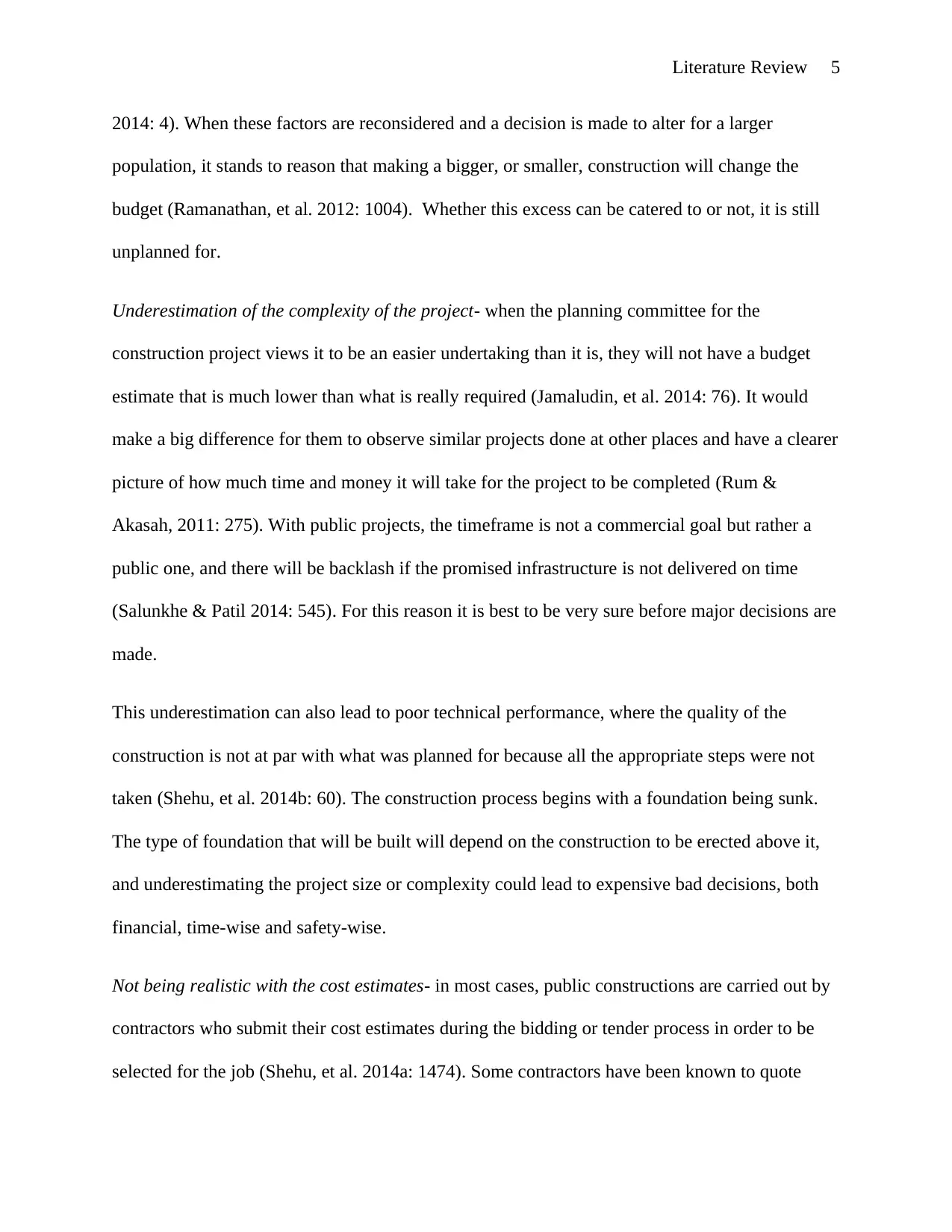
Literature Review 5
2014: 4). When these factors are reconsidered and a decision is made to alter for a larger
population, it stands to reason that making a bigger, or smaller, construction will change the
budget (Ramanathan, et al. 2012: 1004). Whether this excess can be catered to or not, it is still
unplanned for.
Underestimation of the complexity of the project- when the planning committee for the
construction project views it to be an easier undertaking than it is, they will not have a budget
estimate that is much lower than what is really required (Jamaludin, et al. 2014: 76). It would
make a big difference for them to observe similar projects done at other places and have a clearer
picture of how much time and money it will take for the project to be completed (Rum &
Akasah, 2011: 275). With public projects, the timeframe is not a commercial goal but rather a
public one, and there will be backlash if the promised infrastructure is not delivered on time
(Salunkhe & Patil 2014: 545). For this reason it is best to be very sure before major decisions are
made.
This underestimation can also lead to poor technical performance, where the quality of the
construction is not at par with what was planned for because all the appropriate steps were not
taken (Shehu, et al. 2014b: 60). The construction process begins with a foundation being sunk.
The type of foundation that will be built will depend on the construction to be erected above it,
and underestimating the project size or complexity could lead to expensive bad decisions, both
financial, time-wise and safety-wise.
Not being realistic with the cost estimates- in most cases, public constructions are carried out by
contractors who submit their cost estimates during the bidding or tender process in order to be
selected for the job (Shehu, et al. 2014a: 1474). Some contractors have been known to quote
2014: 4). When these factors are reconsidered and a decision is made to alter for a larger
population, it stands to reason that making a bigger, or smaller, construction will change the
budget (Ramanathan, et al. 2012: 1004). Whether this excess can be catered to or not, it is still
unplanned for.
Underestimation of the complexity of the project- when the planning committee for the
construction project views it to be an easier undertaking than it is, they will not have a budget
estimate that is much lower than what is really required (Jamaludin, et al. 2014: 76). It would
make a big difference for them to observe similar projects done at other places and have a clearer
picture of how much time and money it will take for the project to be completed (Rum &
Akasah, 2011: 275). With public projects, the timeframe is not a commercial goal but rather a
public one, and there will be backlash if the promised infrastructure is not delivered on time
(Salunkhe & Patil 2014: 545). For this reason it is best to be very sure before major decisions are
made.
This underestimation can also lead to poor technical performance, where the quality of the
construction is not at par with what was planned for because all the appropriate steps were not
taken (Shehu, et al. 2014b: 60). The construction process begins with a foundation being sunk.
The type of foundation that will be built will depend on the construction to be erected above it,
and underestimating the project size or complexity could lead to expensive bad decisions, both
financial, time-wise and safety-wise.
Not being realistic with the cost estimates- in most cases, public constructions are carried out by
contractors who submit their cost estimates during the bidding or tender process in order to be
selected for the job (Shehu, et al. 2014a: 1474). Some contractors have been known to quote

Literature Review 6
smaller figures for the cost in attempt to look more affordable and therefore get selected. When it
comes down to the execution, however, the lower budget will have to be adjusted severally so
that the project can be completed as promised.
Inadequate financing- for one reason or another, the funding for the project could be stopped and
this will make it difficult or impossible to finish. The government funds public projects, and if
there arise reasons as to why the project being constructed have some negative impact on the
environment or any other factor, it will possibly never be completed (Shrestha, et al. 2013: 7).
Project delays- these can be caused by any number of reasons including delayed funding,
communication breakdown and improper coordination.
little experience of the contractor in handling such a project- a poor leadership structure could
lead to insubordination and improper division of labour which has the ability to not only slow
down pertains but as raise the costs to higher figures than budgeted for (Vaardini, et al. 2016:
359). When the particular construction is not one that the contractor is familiar with, for example
a typical building contractor being charged with building a dam, there is bound to be some
confusion. In a way, it can be assumed that the contractor is learning on the job (Olawale & Sun
2010: 518). This could lead to many unprecedented losses, even in the occasion that all the
materials and equipment gotten for the project were correct and enough. Inexperience and
clumsy steps are an unexpected expense.
lack of coordination- this is when the activities in the construction project have not been clearly
assigned such that there is duplication of duties and delays that arise when workers, who are on
the payroll, have no duties because they have not been allocated any when they in fact should be
working (Amu & Adesanya 2011: 65).
smaller figures for the cost in attempt to look more affordable and therefore get selected. When it
comes down to the execution, however, the lower budget will have to be adjusted severally so
that the project can be completed as promised.
Inadequate financing- for one reason or another, the funding for the project could be stopped and
this will make it difficult or impossible to finish. The government funds public projects, and if
there arise reasons as to why the project being constructed have some negative impact on the
environment or any other factor, it will possibly never be completed (Shrestha, et al. 2013: 7).
Project delays- these can be caused by any number of reasons including delayed funding,
communication breakdown and improper coordination.
little experience of the contractor in handling such a project- a poor leadership structure could
lead to insubordination and improper division of labour which has the ability to not only slow
down pertains but as raise the costs to higher figures than budgeted for (Vaardini, et al. 2016:
359). When the particular construction is not one that the contractor is familiar with, for example
a typical building contractor being charged with building a dam, there is bound to be some
confusion. In a way, it can be assumed that the contractor is learning on the job (Olawale & Sun
2010: 518). This could lead to many unprecedented losses, even in the occasion that all the
materials and equipment gotten for the project were correct and enough. Inexperience and
clumsy steps are an unexpected expense.
lack of coordination- this is when the activities in the construction project have not been clearly
assigned such that there is duplication of duties and delays that arise when workers, who are on
the payroll, have no duties because they have not been allocated any when they in fact should be
working (Amu & Adesanya 2011: 65).
⊘ This is a preview!⊘
Do you want full access?
Subscribe today to unlock all pages.

Trusted by 1+ million students worldwide
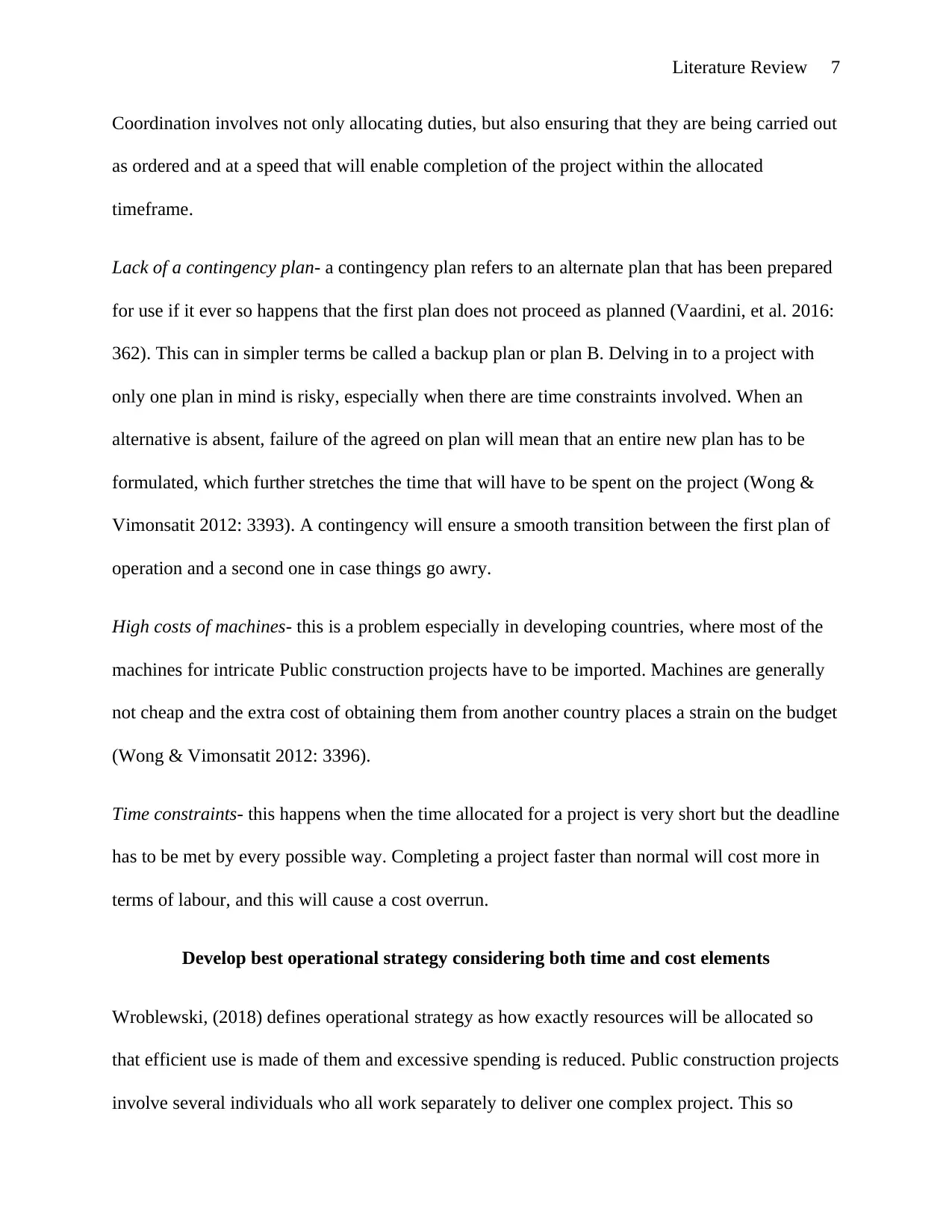
Literature Review 7
Coordination involves not only allocating duties, but also ensuring that they are being carried out
as ordered and at a speed that will enable completion of the project within the allocated
timeframe.
Lack of a contingency plan- a contingency plan refers to an alternate plan that has been prepared
for use if it ever so happens that the first plan does not proceed as planned (Vaardini, et al. 2016:
362). This can in simpler terms be called a backup plan or plan B. Delving in to a project with
only one plan in mind is risky, especially when there are time constraints involved. When an
alternative is absent, failure of the agreed on plan will mean that an entire new plan has to be
formulated, which further stretches the time that will have to be spent on the project (Wong &
Vimonsatit 2012: 3393). A contingency will ensure a smooth transition between the first plan of
operation and a second one in case things go awry.
High costs of machines- this is a problem especially in developing countries, where most of the
machines for intricate Public construction projects have to be imported. Machines are generally
not cheap and the extra cost of obtaining them from another country places a strain on the budget
(Wong & Vimonsatit 2012: 3396).
Time constraints- this happens when the time allocated for a project is very short but the deadline
has to be met by every possible way. Completing a project faster than normal will cost more in
terms of labour, and this will cause a cost overrun.
Develop best operational strategy considering both time and cost elements
Wroblewski, (2018) defines operational strategy as how exactly resources will be allocated so
that efficient use is made of them and excessive spending is reduced. Public construction projects
involve several individuals who all work separately to deliver one complex project. This so
Coordination involves not only allocating duties, but also ensuring that they are being carried out
as ordered and at a speed that will enable completion of the project within the allocated
timeframe.
Lack of a contingency plan- a contingency plan refers to an alternate plan that has been prepared
for use if it ever so happens that the first plan does not proceed as planned (Vaardini, et al. 2016:
362). This can in simpler terms be called a backup plan or plan B. Delving in to a project with
only one plan in mind is risky, especially when there are time constraints involved. When an
alternative is absent, failure of the agreed on plan will mean that an entire new plan has to be
formulated, which further stretches the time that will have to be spent on the project (Wong &
Vimonsatit 2012: 3393). A contingency will ensure a smooth transition between the first plan of
operation and a second one in case things go awry.
High costs of machines- this is a problem especially in developing countries, where most of the
machines for intricate Public construction projects have to be imported. Machines are generally
not cheap and the extra cost of obtaining them from another country places a strain on the budget
(Wong & Vimonsatit 2012: 3396).
Time constraints- this happens when the time allocated for a project is very short but the deadline
has to be met by every possible way. Completing a project faster than normal will cost more in
terms of labour, and this will cause a cost overrun.
Develop best operational strategy considering both time and cost elements
Wroblewski, (2018) defines operational strategy as how exactly resources will be allocated so
that efficient use is made of them and excessive spending is reduced. Public construction projects
involve several individuals who all work separately to deliver one complex project. This so
Paraphrase This Document
Need a fresh take? Get an instant paraphrase of this document with our AI Paraphraser
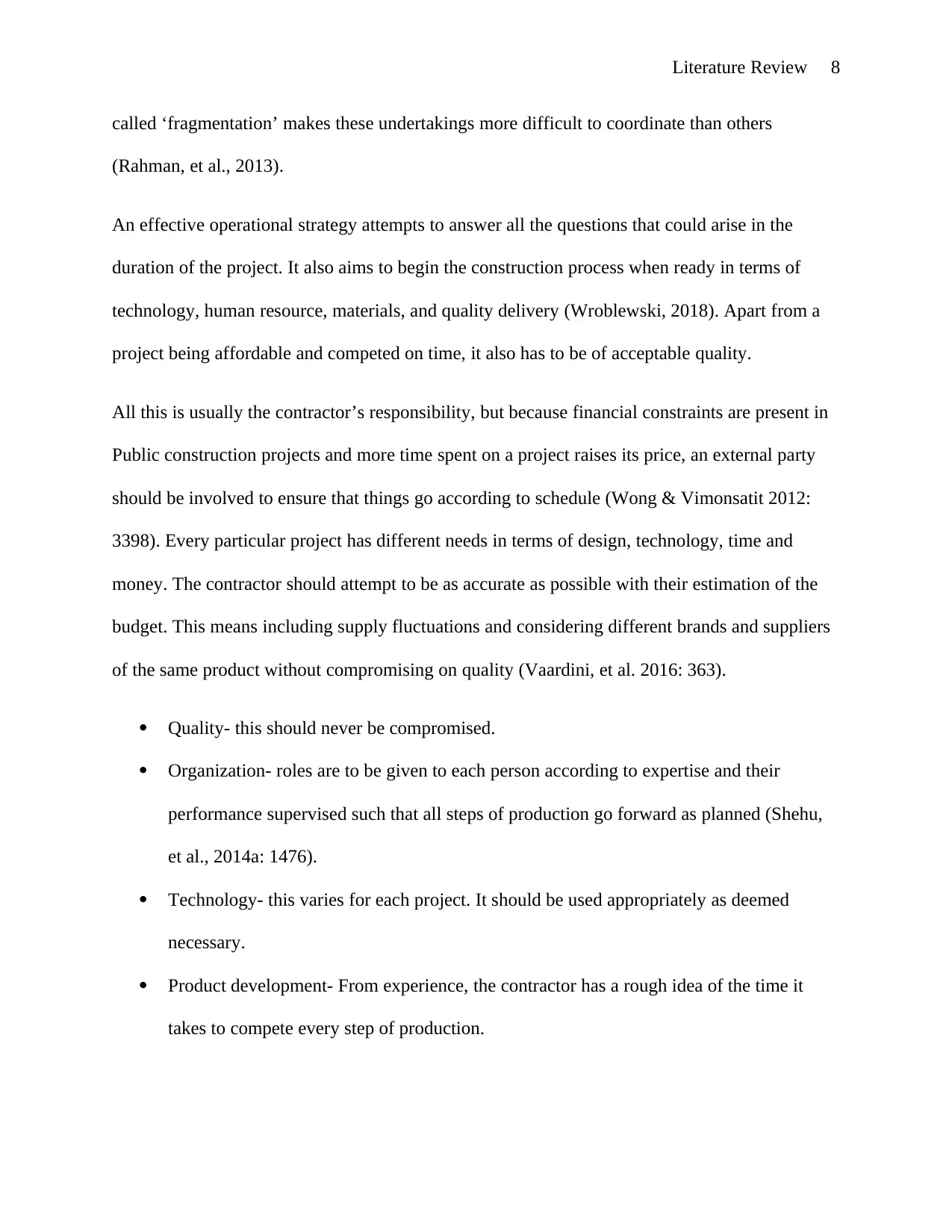
Literature Review 8
called ‘fragmentation’ makes these undertakings more difficult to coordinate than others
(Rahman, et al., 2013).
An effective operational strategy attempts to answer all the questions that could arise in the
duration of the project. It also aims to begin the construction process when ready in terms of
technology, human resource, materials, and quality delivery (Wroblewski, 2018). Apart from a
project being affordable and competed on time, it also has to be of acceptable quality.
All this is usually the contractor’s responsibility, but because financial constraints are present in
Public construction projects and more time spent on a project raises its price, an external party
should be involved to ensure that things go according to schedule (Wong & Vimonsatit 2012:
3398). Every particular project has different needs in terms of design, technology, time and
money. The contractor should attempt to be as accurate as possible with their estimation of the
budget. This means including supply fluctuations and considering different brands and suppliers
of the same product without compromising on quality (Vaardini, et al. 2016: 363).
Quality- this should never be compromised.
Organization- roles are to be given to each person according to expertise and their
performance supervised such that all steps of production go forward as planned (Shehu,
et al., 2014a: 1476).
Technology- this varies for each project. It should be used appropriately as deemed
necessary.
Product development- From experience, the contractor has a rough idea of the time it
takes to compete every step of production.
called ‘fragmentation’ makes these undertakings more difficult to coordinate than others
(Rahman, et al., 2013).
An effective operational strategy attempts to answer all the questions that could arise in the
duration of the project. It also aims to begin the construction process when ready in terms of
technology, human resource, materials, and quality delivery (Wroblewski, 2018). Apart from a
project being affordable and competed on time, it also has to be of acceptable quality.
All this is usually the contractor’s responsibility, but because financial constraints are present in
Public construction projects and more time spent on a project raises its price, an external party
should be involved to ensure that things go according to schedule (Wong & Vimonsatit 2012:
3398). Every particular project has different needs in terms of design, technology, time and
money. The contractor should attempt to be as accurate as possible with their estimation of the
budget. This means including supply fluctuations and considering different brands and suppliers
of the same product without compromising on quality (Vaardini, et al. 2016: 363).
Quality- this should never be compromised.
Organization- roles are to be given to each person according to expertise and their
performance supervised such that all steps of production go forward as planned (Shehu,
et al., 2014a: 1476).
Technology- this varies for each project. It should be used appropriately as deemed
necessary.
Product development- From experience, the contractor has a rough idea of the time it
takes to compete every step of production.
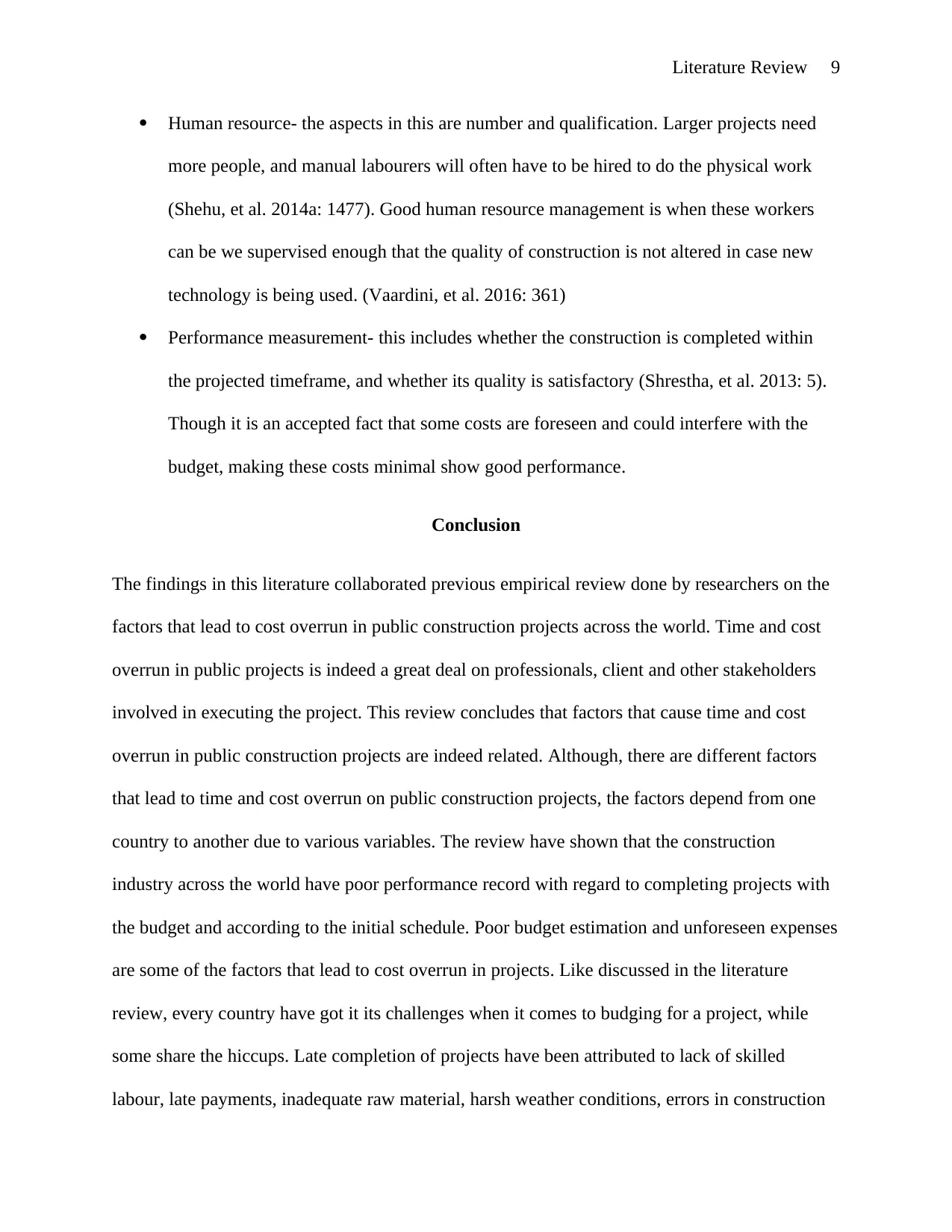
Literature Review 9
Human resource- the aspects in this are number and qualification. Larger projects need
more people, and manual labourers will often have to be hired to do the physical work
(Shehu, et al. 2014a: 1477). Good human resource management is when these workers
can be we supervised enough that the quality of construction is not altered in case new
technology is being used. (Vaardini, et al. 2016: 361)
Performance measurement- this includes whether the construction is completed within
the projected timeframe, and whether its quality is satisfactory (Shrestha, et al. 2013: 5).
Though it is an accepted fact that some costs are foreseen and could interfere with the
budget, making these costs minimal show good performance.
Conclusion
The findings in this literature collaborated previous empirical review done by researchers on the
factors that lead to cost overrun in public construction projects across the world. Time and cost
overrun in public projects is indeed a great deal on professionals, client and other stakeholders
involved in executing the project. This review concludes that factors that cause time and cost
overrun in public construction projects are indeed related. Although, there are different factors
that lead to time and cost overrun on public construction projects, the factors depend from one
country to another due to various variables. The review have shown that the construction
industry across the world have poor performance record with regard to completing projects with
the budget and according to the initial schedule. Poor budget estimation and unforeseen expenses
are some of the factors that lead to cost overrun in projects. Like discussed in the literature
review, every country have got it its challenges when it comes to budging for a project, while
some share the hiccups. Late completion of projects have been attributed to lack of skilled
labour, late payments, inadequate raw material, harsh weather conditions, errors in construction
Human resource- the aspects in this are number and qualification. Larger projects need
more people, and manual labourers will often have to be hired to do the physical work
(Shehu, et al. 2014a: 1477). Good human resource management is when these workers
can be we supervised enough that the quality of construction is not altered in case new
technology is being used. (Vaardini, et al. 2016: 361)
Performance measurement- this includes whether the construction is completed within
the projected timeframe, and whether its quality is satisfactory (Shrestha, et al. 2013: 5).
Though it is an accepted fact that some costs are foreseen and could interfere with the
budget, making these costs minimal show good performance.
Conclusion
The findings in this literature collaborated previous empirical review done by researchers on the
factors that lead to cost overrun in public construction projects across the world. Time and cost
overrun in public projects is indeed a great deal on professionals, client and other stakeholders
involved in executing the project. This review concludes that factors that cause time and cost
overrun in public construction projects are indeed related. Although, there are different factors
that lead to time and cost overrun on public construction projects, the factors depend from one
country to another due to various variables. The review have shown that the construction
industry across the world have poor performance record with regard to completing projects with
the budget and according to the initial schedule. Poor budget estimation and unforeseen expenses
are some of the factors that lead to cost overrun in projects. Like discussed in the literature
review, every country have got it its challenges when it comes to budging for a project, while
some share the hiccups. Late completion of projects have been attributed to lack of skilled
labour, late payments, inadequate raw material, harsh weather conditions, errors in construction
⊘ This is a preview!⊘
Do you want full access?
Subscribe today to unlock all pages.

Trusted by 1+ million students worldwide

Literature Review 10
documents, poor designs, lack of specified deadlines among other factors. The review then
culminates by giving some of the mitigation measures that can be implemented in projects to
deal with cost overruns include embedding the human, material and technical resource
management system since most of the cost overrun are associated to poor management.
Moreover, ensuring that there is an effective communication between all the stakeholders in the
construction project can help reduce cost overrun and be successful in project delivery.
documents, poor designs, lack of specified deadlines among other factors. The review then
culminates by giving some of the mitigation measures that can be implemented in projects to
deal with cost overruns include embedding the human, material and technical resource
management system since most of the cost overrun are associated to poor management.
Moreover, ensuring that there is an effective communication between all the stakeholders in the
construction project can help reduce cost overrun and be successful in project delivery.
Paraphrase This Document
Need a fresh take? Get an instant paraphrase of this document with our AI Paraphraser

Literature Review 11
References
Ali A S and Kamaruzzaman S N (2010) Cost performance for building Public construction
projects in Klang Valley: J. Build. Perform. 1 110–118.
Amu O and Adesanya D A (2011) Mathematical expressions for explaining project delays in
South Western Nigeria: Singapore J. Sci. Res. 1 59–67.
Ameh O J, Soyingbe A, and Odusami K T (2010) Significant factors causing cost overruns in
telecommunication projects in Nigeria: J. Constr. Dev. Ctries. 15 49–67.
Amoa K and Allotey S (2014) Cost overruns in building construction project: A case study of a
government of Ghana project in Accra: Dev. Ctry. Stud. 4 54–65.
Azlan O and Syuhada I (2014) Delay in government project delivery in Kedah, Malaysia Proc.
Of Recent Advances in Civil Engineering and Mechanics (Florence, Italy): WSEAS Press pp
248–254.
Ismail I, Memon A H, and Rahman I R (2014) Expert opinion on risk level for factors affecting
time and cost overrun along the project lifecycle in Malaysian Public construction projects: Int. J.
Constr. Technoogy Manag. 1 10–15.
Jamaludin S H, Mohammad M F and Ahmad K (2014) Enhancing the quality of construction
environment by minimizing the cost variance: Procedia - Social and Behavioral Sciences, vol
153 (United Kingdom: Elsevier) pp 70–78.
Lidelöw, H. and Simu, K., (2015). Understanding construction contractors and their operations
strategies: Procedia Economics and Finance, 21, pp.48-56.
Memon A H (2014) Contractor perspective on time overrun factors in Malaysian Public
construction projects: Int. J. Sci. Environ. Technol. 3 1184–1192.
Mydin M A, Sani N M, Salim N and Alias M (2014) Assessment of influential causes of
construction project delay in Malaysian private housing from developer’s viewpoint E3S Web of
Conf. vol 3 (Paris: EDP Sciences) 01027.
References
Ali A S and Kamaruzzaman S N (2010) Cost performance for building Public construction
projects in Klang Valley: J. Build. Perform. 1 110–118.
Amu O and Adesanya D A (2011) Mathematical expressions for explaining project delays in
South Western Nigeria: Singapore J. Sci. Res. 1 59–67.
Ameh O J, Soyingbe A, and Odusami K T (2010) Significant factors causing cost overruns in
telecommunication projects in Nigeria: J. Constr. Dev. Ctries. 15 49–67.
Amoa K and Allotey S (2014) Cost overruns in building construction project: A case study of a
government of Ghana project in Accra: Dev. Ctry. Stud. 4 54–65.
Azlan O and Syuhada I (2014) Delay in government project delivery in Kedah, Malaysia Proc.
Of Recent Advances in Civil Engineering and Mechanics (Florence, Italy): WSEAS Press pp
248–254.
Ismail I, Memon A H, and Rahman I R (2014) Expert opinion on risk level for factors affecting
time and cost overrun along the project lifecycle in Malaysian Public construction projects: Int. J.
Constr. Technoogy Manag. 1 10–15.
Jamaludin S H, Mohammad M F and Ahmad K (2014) Enhancing the quality of construction
environment by minimizing the cost variance: Procedia - Social and Behavioral Sciences, vol
153 (United Kingdom: Elsevier) pp 70–78.
Lidelöw, H. and Simu, K., (2015). Understanding construction contractors and their operations
strategies: Procedia Economics and Finance, 21, pp.48-56.
Memon A H (2014) Contractor perspective on time overrun factors in Malaysian Public
construction projects: Int. J. Sci. Environ. Technol. 3 1184–1192.
Mydin M A, Sani N M, Salim N and Alias M (2014) Assessment of influential causes of
construction project delay in Malaysian private housing from developer’s viewpoint E3S Web of
Conf. vol 3 (Paris: EDP Sciences) 01027.
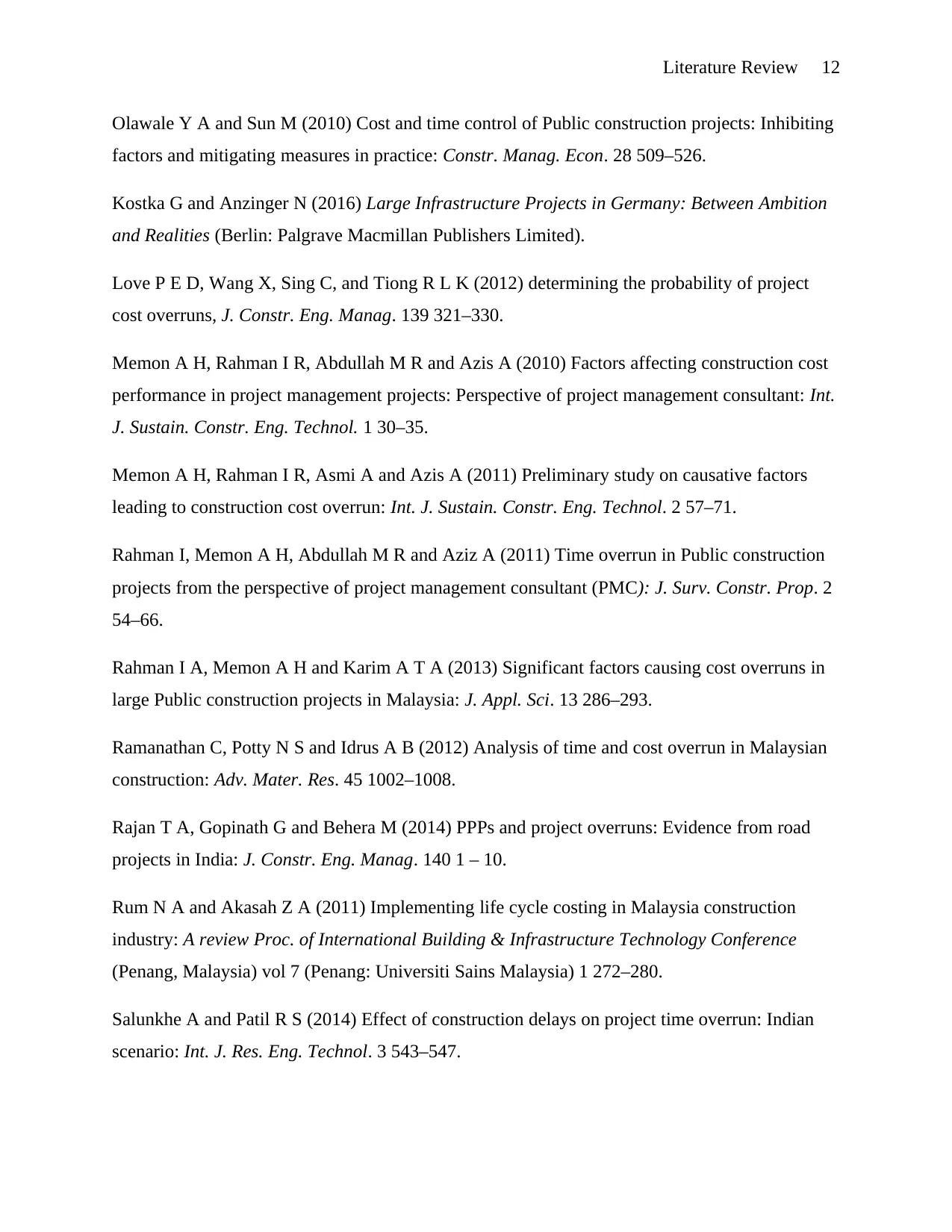
Literature Review 12
Olawale Y A and Sun M (2010) Cost and time control of Public construction projects: Inhibiting
factors and mitigating measures in practice: Constr. Manag. Econ. 28 509–526.
Kostka G and Anzinger N (2016) Large Infrastructure Projects in Germany: Between Ambition
and Realities (Berlin: Palgrave Macmillan Publishers Limited).
Love P E D, Wang X, Sing C, and Tiong R L K (2012) determining the probability of project
cost overruns, J. Constr. Eng. Manag. 139 321–330.
Memon A H, Rahman I R, Abdullah M R and Azis A (2010) Factors affecting construction cost
performance in project management projects: Perspective of project management consultant: Int.
J. Sustain. Constr. Eng. Technol. 1 30–35.
Memon A H, Rahman I R, Asmi A and Azis A (2011) Preliminary study on causative factors
leading to construction cost overrun: Int. J. Sustain. Constr. Eng. Technol. 2 57–71.
Rahman I, Memon A H, Abdullah M R and Aziz A (2011) Time overrun in Public construction
projects from the perspective of project management consultant (PMC): J. Surv. Constr. Prop. 2
54–66.
Rahman I A, Memon A H and Karim A T A (2013) Significant factors causing cost overruns in
large Public construction projects in Malaysia: J. Appl. Sci. 13 286–293.
Ramanathan C, Potty N S and Idrus A B (2012) Analysis of time and cost overrun in Malaysian
construction: Adv. Mater. Res. 45 1002–1008.
Rajan T A, Gopinath G and Behera M (2014) PPPs and project overruns: Evidence from road
projects in India: J. Constr. Eng. Manag. 140 1 – 10.
Rum N A and Akasah Z A (2011) Implementing life cycle costing in Malaysia construction
industry: A review Proc. of International Building & Infrastructure Technology Conference
(Penang, Malaysia) vol 7 (Penang: Universiti Sains Malaysia) 1 272–280.
Salunkhe A and Patil R S (2014) Effect of construction delays on project time overrun: Indian
scenario: Int. J. Res. Eng. Technol. 3 543–547.
Olawale Y A and Sun M (2010) Cost and time control of Public construction projects: Inhibiting
factors and mitigating measures in practice: Constr. Manag. Econ. 28 509–526.
Kostka G and Anzinger N (2016) Large Infrastructure Projects in Germany: Between Ambition
and Realities (Berlin: Palgrave Macmillan Publishers Limited).
Love P E D, Wang X, Sing C, and Tiong R L K (2012) determining the probability of project
cost overruns, J. Constr. Eng. Manag. 139 321–330.
Memon A H, Rahman I R, Abdullah M R and Azis A (2010) Factors affecting construction cost
performance in project management projects: Perspective of project management consultant: Int.
J. Sustain. Constr. Eng. Technol. 1 30–35.
Memon A H, Rahman I R, Asmi A and Azis A (2011) Preliminary study on causative factors
leading to construction cost overrun: Int. J. Sustain. Constr. Eng. Technol. 2 57–71.
Rahman I, Memon A H, Abdullah M R and Aziz A (2011) Time overrun in Public construction
projects from the perspective of project management consultant (PMC): J. Surv. Constr. Prop. 2
54–66.
Rahman I A, Memon A H and Karim A T A (2013) Significant factors causing cost overruns in
large Public construction projects in Malaysia: J. Appl. Sci. 13 286–293.
Ramanathan C, Potty N S and Idrus A B (2012) Analysis of time and cost overrun in Malaysian
construction: Adv. Mater. Res. 45 1002–1008.
Rajan T A, Gopinath G and Behera M (2014) PPPs and project overruns: Evidence from road
projects in India: J. Constr. Eng. Manag. 140 1 – 10.
Rum N A and Akasah Z A (2011) Implementing life cycle costing in Malaysia construction
industry: A review Proc. of International Building & Infrastructure Technology Conference
(Penang, Malaysia) vol 7 (Penang: Universiti Sains Malaysia) 1 272–280.
Salunkhe A and Patil R S (2014) Effect of construction delays on project time overrun: Indian
scenario: Int. J. Res. Eng. Technol. 3 543–547.
⊘ This is a preview!⊘
Do you want full access?
Subscribe today to unlock all pages.

Trusted by 1+ million students worldwide
1 out of 13
Related Documents
Your All-in-One AI-Powered Toolkit for Academic Success.
+13062052269
info@desklib.com
Available 24*7 on WhatsApp / Email
![[object Object]](/_next/static/media/star-bottom.7253800d.svg)
Unlock your academic potential
Copyright © 2020–2025 A2Z Services. All Rights Reserved. Developed and managed by ZUCOL.





